
The geopolitics of energy has been the subject of massively increased attention since Russia’s invasion of Ukraine began almost six months ago. The history of the Russia–Ukraine conflict is shot through with Russian attempts to bypass Ukraine as a gas transit state and German decisions on the Nord Stream 2 project. Now, as the northern winter lumbers into view, Europe must somehow find a way to balance its continuing dependence on Russian gas with the need to keep pressure on the Kremlin. The flow-on effects of the crisis in Europe for the US, Australia and elsewhere have also garnered much attention.
Our preoccupation with energy as a key dimension of geopolitics will persist beyond the Russia–Ukraine war, however. This is well and widely understood at the macro level. In Australia, however, there’s relatively little sustained commentary or analysis on this feature of the international landscape, either globally, with a view to the Indo-Pacific or with a view to Australian interests.
For example, remarkably, the updated edition of Allan Gyngell’s Fear of abandonment, a high-quality, go-to reference for Australian foreign policy from 1942 to 2021, carries an index with no entries for ‘oil’, ‘energy’, ‘coal’ and ‘gas’ (though there is one for ‘OPEC’, and the book certainly addresses climate change). Searches of academic journals produce similarly scant results.
ASPI has published some work on this area. Maria Pastukhova’s excellent chapter in ASPI’s The geopolitics of climate and security in the Indo-Pacific interrogates the geopolitics of the energy transition in the Indo-Pacific. She paints a messy picture of the Southeast Asian path forward alongside energy competition as a key feature of China–India competition. Ulas Yildirim’s recent report on the future energy needs of the Australian Defence Force points out just how vulnerable liquid fuel supplies are likely to be as the energy transition deepens over time. And David Uren’s economic commentary in The Strategist has regularly included astute analysis of global energy developments.
This is the first of a series that will provide a brief, ongoing review of developments in this area. This first piece frames an approach—one that will no doubt evolve over time. A second will follow examining some recent news.
Contemporary energy geopolitics pivots on legacy energy supplies like coal and oil, growing renewable supplies and, critically, the transition between the two.
The ongoing importance of legacy fossil-fuel sources to the global political economy is one key starting point. The world transport system and modern militaries are still utterly dependent on oil. Most economies are still utterly dependent on gas- and coal-fired power generation. Other economies are still dependent on exporting these commodities—most obviously, Russia, but they are significant for others like Indonesia (and, yes, Australia).
The transition to renewables is occurring at a massive but uneven scale across the globe. Much commentary is rightly focused on mobilising investment in green technology. Megaprojects, such as China’s 450-gigawatt solar and wind project in the Gobi Desert, are occurring alongside more progressive but equally significant penetration of energy markets by renewables in countries like Australia.
Among any number of other developments, we should be concerned about the politics of Organization of Petroleum Exporting Countries and traditional major oil producers; Russia–China cooperation on energy as the former tries to diversify its gas export markets; high-cost non-traditional fossil fuel sources, particularly in the United States, and their viability; green technology supply chains; private and public investment flows to both legacy and renewable sources; and green technology unknowns and disruptions.
So, how might we usefully watch developments in this area?
In the first instance, following the compelling work of British political economist Helen Thompson, ‘a greener politics will not transcend tragedy’. The long-term, optimistic view that a world delinked from commodities like oil that have been so woven into violent conflict might be a better world does not and cannot obviate countervailing challenges.
One is the reality of that our dependence on a number of fossil fuel commodities will continue for some years, even under an accelerated green transition. The difficulties of legacy energy supply will potentially get more, not less, acute as investment flows towards green alternatives. Another is the dependence on different commodities, like rare-earth minerals, that has already emerged with green energy technologies.
Second, an attentiveness to the contradictions wrapped up in contemporary and future energy geopolitics is key. Historian (and author of the excellent Chartbook newsletter) Adam Tooze is always instructive here.
For example, Tooze has observed of recent events in the US: ‘With US President Joe Biden’s administration, cognitive dissonance returned [after climate action was overtly rejected under President Donald Trump]. Biden supports climate leadership and made a constructive contribution to the Glasgow negotiations while licensing oil and gas development and goading OPEC into increasing its production.’
In this case, Biden is (among other things) a conscript to the longstanding relationship between energy prices, inflation and electoral politics in the US—a consideration that is not irrelevant in Australia. It can be and is true that trends like the tumbling cost of solar and wind generation augur a better long-term future, while not solving the economic and financial dilemmas of the transition that will take decades to complete at a global scale.
Third, analyses of energy geopolitics will increasingly need to be framed around the profound human and political costs that are already being imposed by the impacts of climate change. Deeper impacts are likely to be experienced much sooner than many would like to think, and Australia’s near region is exceptionally exposed. Much Australian attention is directed to the existential nature of this issue for the Pacific islands, but what does Indonesia look like at 3°C of warming, for instance?
The world simply must transition as urgently as possible to avoid worse impacts than those we’ve already locked in.
Energy geopolitics will continue to be a feature of the international landscape, deeply intertwined with almost every other major decision facing leaders, and a robust understanding of the issues will be more important than ever.